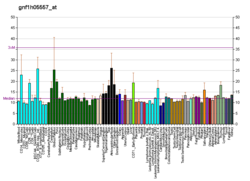Protein-coding gene in the species Homo sapiens
| OR10G4 |
|---|
|
| Identifiers |
|---|
| Aliases | OR10G4, OR11-278, olfactory receptor family 10 subfamily G member 4 |
|---|
| External IDs | MGI: 3030814; HomoloGene: 81557; GeneCards: OR10G4; OMA:OR10G4 - orthologs |
|---|
| Gene location (Human) |
|---|
 | | Chr. | Chromosome 11 (human)[1] |
|---|
| | Band | 11q24.2 | Start | 124,012,997 bp[1] |
|---|
| End | 124,018,732 bp[1] |
|---|
|
| Gene location (Mouse) |
|---|
 | | Chr. | Chromosome 9 (mouse)[2] |
|---|
| | Band | 9|9 A5.1 | Start | 39,915,644 bp[2] |
|---|
| End | 39,920,878 bp[2] |
|---|
|
| RNA expression pattern |
|---|
| Bgee | | Human | Mouse (ortholog) |
|---|
| Top expressed in | - testicle
- body of pancreas
- mucosa of transverse colon
- placenta
- rectum
|
| | | More reference expression data |
|
|---|
| BioGPS |  | | More reference expression data |
|
|---|
|
| Gene ontology |
|---|
| Molecular function | - G protein-coupled receptor activity
- signal transducer activity
- olfactory receptor activity
| | Cellular component | - plasma membrane
- membrane
- integral component of membrane
| | Biological process | - signal transduction
- response to stimulus
- sensory perception of smell
- detection of chemical stimulus involved in sensory perception of smell
- G protein-coupled receptor signaling pathway
| | Sources:Amigo / QuickGO |
|
| Orthologs |
|---|
| Species | Human | Mouse |
|---|
| Entrez | | |
|---|
| Ensembl | | |
|---|
| UniProt | | |
|---|
| RefSeq (mRNA) | | |
|---|
| RefSeq (protein) | | |
|---|
| Location (UCSC) | Chr 11: 124.01 – 124.02 Mb | Chr 9: 39.92 – 39.92 Mb |
|---|
| PubMed search | [3] | [4] |
|---|
|
| Wikidata |
| View/Edit Human | View/Edit Mouse |
|
Olfactory receptor 10G4 is a protein that in humans is encoded by the OR10G4 gene.[5]
Olfactory receptors interact with odorant molecules in the nose, to initiate a neuronal response that triggers the perception of a smell. The olfactory receptor proteins are members of a large family of G-protein-coupled receptors (GPCR) arising from single coding-exon genes. Olfactory receptors share a 7-transmembrane domain structure with many neurotransmitter and hormone receptors and are responsible for the recognition and G protein-mediated transduction of odorant signals. The olfactory receptor gene family is the largest in the genome. The nomenclature assigned to the olfactory receptor genes and proteins for this organism is independent of other organisms.[5]
Genetic differences
Nonsynonymous substitutions in the OR10G4 gene have a significant effect on the perception of the "smoky" odorant guaiacol. Individuals with mutations that reduce the affinity of the OR10G4 receptor for guaiacol have a reduced sensitivity to it, and the same people who report guaiacol as weaker tend to rate it as more pleasant.[6]
See also
References
- ^ a b c GRCh38: Ensembl release 89: ENSG00000254737 – Ensembl, May 2017
- ^ a b c GRCm38: Ensembl release 89: ENSMUSG00000060254 – Ensembl, May 2017
- ^ "Human PubMed Reference:". National Center for Biotechnology Information, U.S. National Library of Medicine.
- ^ "Mouse PubMed Reference:". National Center for Biotechnology Information, U.S. National Library of Medicine.
- ^ a b "Entrez Gene: OR10G4 olfactory receptor, family 10, subfamily G, member 4".
- ^ Mainland JD, Keller A, Li YR, Zhou T, Trimmer C, Snyder LL, et al. (January 2014). "The missense of smell: functional variability in the human odorant receptor repertoire". Nature Neuroscience. 17 (1): 114–20. doi:10.1038/nn.3598. PMC 3990440. PMID 24316890.
Further reading
- Malnic B, Godfrey PA, Buck LB (February 2004). "The human olfactory receptor gene family". Proceedings of the National Academy of Sciences of the United States of America. 101 (8): 2584–9. Bibcode:2004PNAS..101.2584M. doi:10.1073/pnas.0307882100. PMC 356993. PMID 14983052.
External links
This article incorporates text from the United States National Library of Medicine, which is in the public domain.
Class I
(fish-like receptors) | | Family 51 | |
|---|
| Family 52 | |
|---|
| Family 56 | |
|---|
|
|---|
Class II
(tetrapod specific receptors) | | Family 1 | |
|---|
| Family 2 | |
|---|
| Family 3 | |
|---|
| Family 4 | |
|---|
| Family 5 | |
|---|
| Family 6 | |
|---|
| Family 7 | |
|---|
| Family 8 | |
|---|
| Family 9 | |
|---|
| Family 10 | |
|---|
| Family 11 | |
|---|
| Family 12 | |
|---|
| Family 13 | |
|---|
|
|---|

















